Helen Burgess, Krystin Gollihue, and Stacey Pigg, North Carolina State University
(Published November 18, 2019)
I: Introduction
The Fates of Things had its birth in a performance the authors conducted in the Spring of 2017, as one panel at the R-CADE (Rutgers-Camden Archive of Digital Ephemera) Symposium run at Rutgers University-Camden Digital Studies Center. This annual event, curated by Center administrators Jim Brown and Robert Emmons, has typically featured a concentrated set of panels and keynotes delivered in one day and addressing a specific technology, but the 2017 symposium widened its focus to encompass multiple technologies. In responding to R-CADE’s call for work in “digital ephemera,” we decided to take it all the way back to basics, starting with the original digits: our nimble, expressive fingers. In the vein of recent analyses in rhetorical and literary studies from scholars such as Angela Haas, Whitney Trettien, and Gabriela Raquel Ríos, as well as recent projects in the digital humanities including Michigan State’s Quilt Index and the University of Copenhagen’s Centre for Textile Research, we approached the embodiment of digital ephemera through intellectual traditions related to the creation of textiles. The panel explored what it means to be simultaneously embodied and digital, using the dual concreteness and ephemerality of two ancient technologies and one modern: the spinning wheel, the loom, and the 3D printer.
Textile technologies represent unique opportunities for exploring the intersections of embodiment, materiality, and textuality. As projects such as the Virtual Textile Project demonstrate, fabrics and other cloth or threaded artifacts are mirrors into the social and cultural life of societies that create them (Bradley). Amanda Sikarsie in Textile Collections: Access, Curation, and Interpretation in the Digital Age argues that textiles represent “an important theoretical construct and point of reference not only because of the myriad ways that museum professionals, archivists, artists, and others are creating preserving, sharing, curating, and interpreting digital textiles but also because of the intimate historical connection between textiles and technologies” (xi-xii). In this project, our goal was to build on the inherent relationship among textiles and technologies to explore how technological use invokes intricate movements, hauntings, material histories, and even deaths that can be easily forgotten when we archive and curate artifacts that stand in as representations of complex interactions.
It is particularly easy to lose the ephemeral meanings, moments, and materials associated with forms of technological use that are often positioned as gendered labor. As Jacqueline Wernimont’s Introduction to the Digital Humanities Quarterly special issue on Feminisms and Digital Humanities reminds us, feminist work is often embodied, which makes it complicated to “capture,” access, trace, and value. Although the historic and gendered relations associated with creating fabric and cloth across cultures are actually quite complex, fiber arts today are often understood as women’s work and are thus even more likely to fall below the level of our attention.
In order to uncover fleeting relations between technologies, textuality, and embodiment, our approach to this panel was performative, both in language and in embodied action. We drew on Johanna Drucker’s concept of performative materiality, in which she argues that “what something is has to be understood in terms of what it does, how it works within machinic, systemic, and cultural domains” (4). The goal for our panel was to create interpretative events by inhabiting relations with both textile technologies and embodied makers, shifting the focus of “ephemera” in this case by positioning technologies, artifacts, and makers as events rather than entities. That is, in Drucker’s terms, our panel provided the opportunity to open discussions with conference attendees and future readers about textile technologies and relations through public performances of both identity roles and technology use. We spun, wove, and printed as mythical makers in order to emphasize how the transient nature of materiality is contingent and “always in flux” when “exposed by the performative dimension of use” (12).
Our embodiment, too, represented an opportunity for performances that uncovered ephemeral and gendered relations. As a framing narrative for the work, we chose to inhabit the identities of the three classical Fates: Clotho, who spins the thread of human life (Helen, on spinning wheel), Lachesis, who measures it (Stacey, on loom), and Atropos (Krystin, on 3D printer), who cuts the thread at the end of life. Each technology was embedded with an accelerometer, capturing the combined movements of machine and body as we performed. In a final act of translation, we took the data generated by all three accelerometers and created poems with them, which were posted live to Twitter during the performance. Each Fate selected a set of six texts that seemed resonant with their character and tools and used the accelerometer data as a way of cutting up and remixing those texts.
The loom has long been acknowledged as a forerunner of computing. Placement of shuttles and heddles produce “digital” patterns using the binary means of “up/down” (or “over/under”); textile art is thus a kind of “digital expression” (in the modern sense) of “digital movement” as our hands and fingers knot, tie, and weave fiber through space. Bookending this technology, we chose the spinning wheel (which enacts a combination of technologies, fingers and feet) and the 3D printer (an expression of binary code without direct physical intervention, that nonetheless produces algorithmically-crafted objects we can pick up and interact with).
Taken together, these three machines represent a continuum from “old digital” (fingers) to “new digital” (binary code). All three technologies are responsible for creating materiality from ephemerality: whether that be the streaming of fingers through fiber, or the streaming of data through the printer head extruder. Thus, they act as a kind of translation media between the immaterial/ephemeral and the material/object. The panel we enacted at R-CADE dove into this act of translation. The two technologies of spinning wheel and loom were embedded with a sensor that reported movement data from their respective parts (the accelerometer, attached to the wheel and loom shuttle).
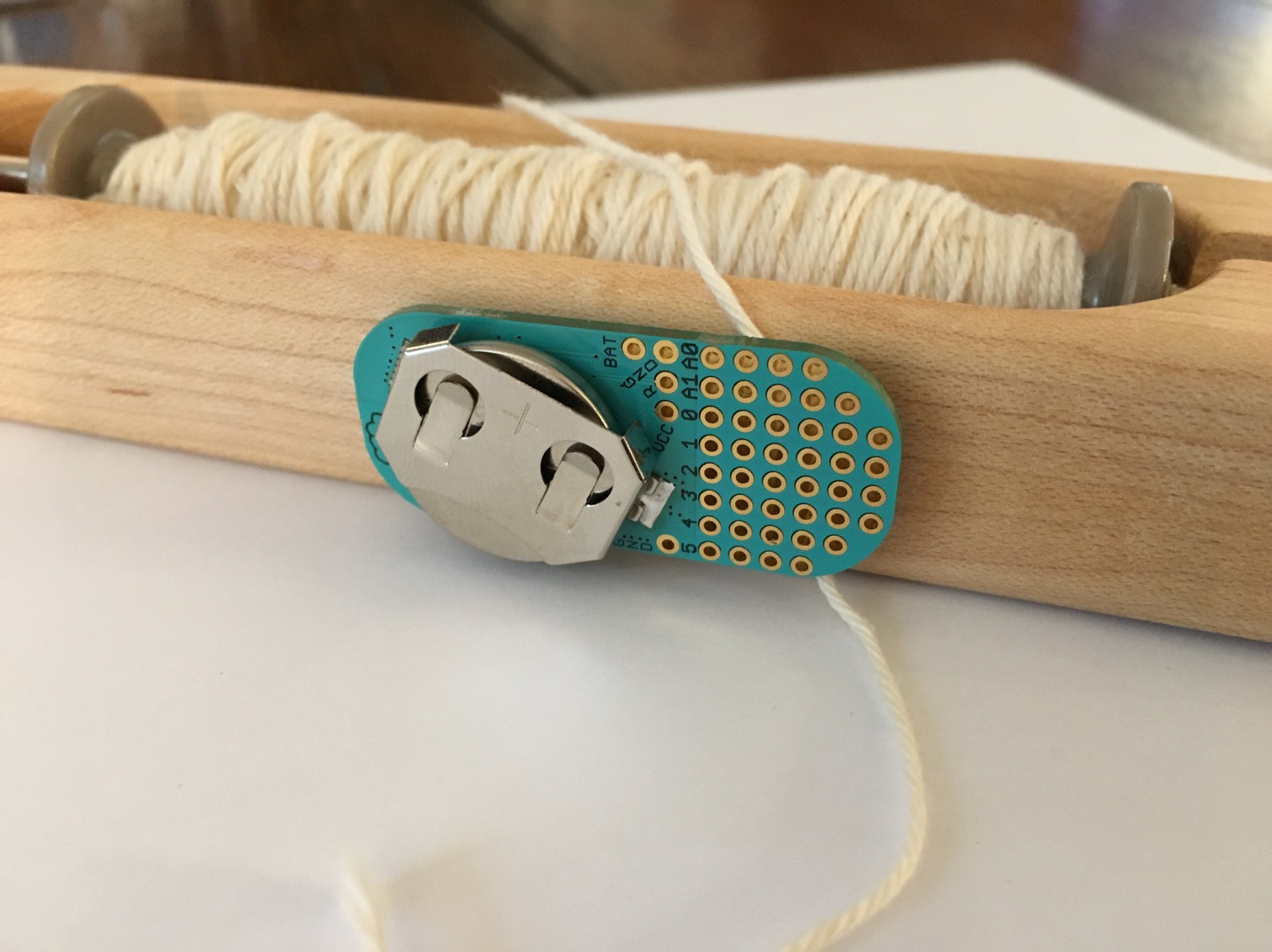
Figure 1. Lachesis. Accelerometer attached to boat shuttle used in weaving.
The resulting streams of data were then captured and translated into coordinates that allowed for 3D printing files. In doing so, we captured the act of craft not only via its usual physical record (fiber and fabric) but also in terms of embodied movement: movement of the foot, pumping the axle driving the spinning wheel; movement of the hand guiding shuttle through cloth. In turn, the 3D printer head was embedded with another accelerometer sensor, which caught a final stream of data as the objects were printed.
Clotho and Lachesis—spinner and weaver, respectively—create the fiber and fabric of life. Helen and Stacey replicated this activity, first spinning fiber and then weaving it into a textile fashioning of a human life. Atropos, meaning “unchangeable” (and sometimes “changes all”), is concerned with cutting the thread of life, of making an ephemeral life permanent in death. By embodying Atropos, Krystin transduced the ephemeral data gleaned from Clotho the spinner and Lachesis the weaver into a 3D printed model and sealed the reincarnation of traditional material media into digital permanence. The recursive movement between permanent material, impermanent data, and solid model of the 3D printed object itself, acted in the same ways that the lives Atropos cuts short do. The object’s making is itself a cutting of the thread, solidifying life’s ephemerality.
In what follows, we present the following materials for readers to read, reproduce, and inhabit:
- A description of the technology and method used to capture data;
- Open Source python scripts for capturing accelerometer data, translating it into poems, and posting those poems to Twitter;
- “Human scripts” recording each panelist’s performance on the day of the panel; and
- links to each Fate’s Twitter feed.
II: Technical Specifications
Technology
The Fates of Things makes use of a highly compact Arduino-based board called the LightBlue Bean, which features a central Arduino processor, a built-in accelerometer, and a Bluetooth Low Energy (BLE) communication tool, all integrated on a small board about the size of two quarters sitting next to one another, and powered by a coin cell lithium battery that sits on the rear of the board. The Bean system was particularly suitable for our purposes because it did not require any wire hookups or soldering between components: an important consideration when working with fast moving technologies such as a spinning wheel. We attached the Beans to our respective technologies with Velcro dots for easy removal.
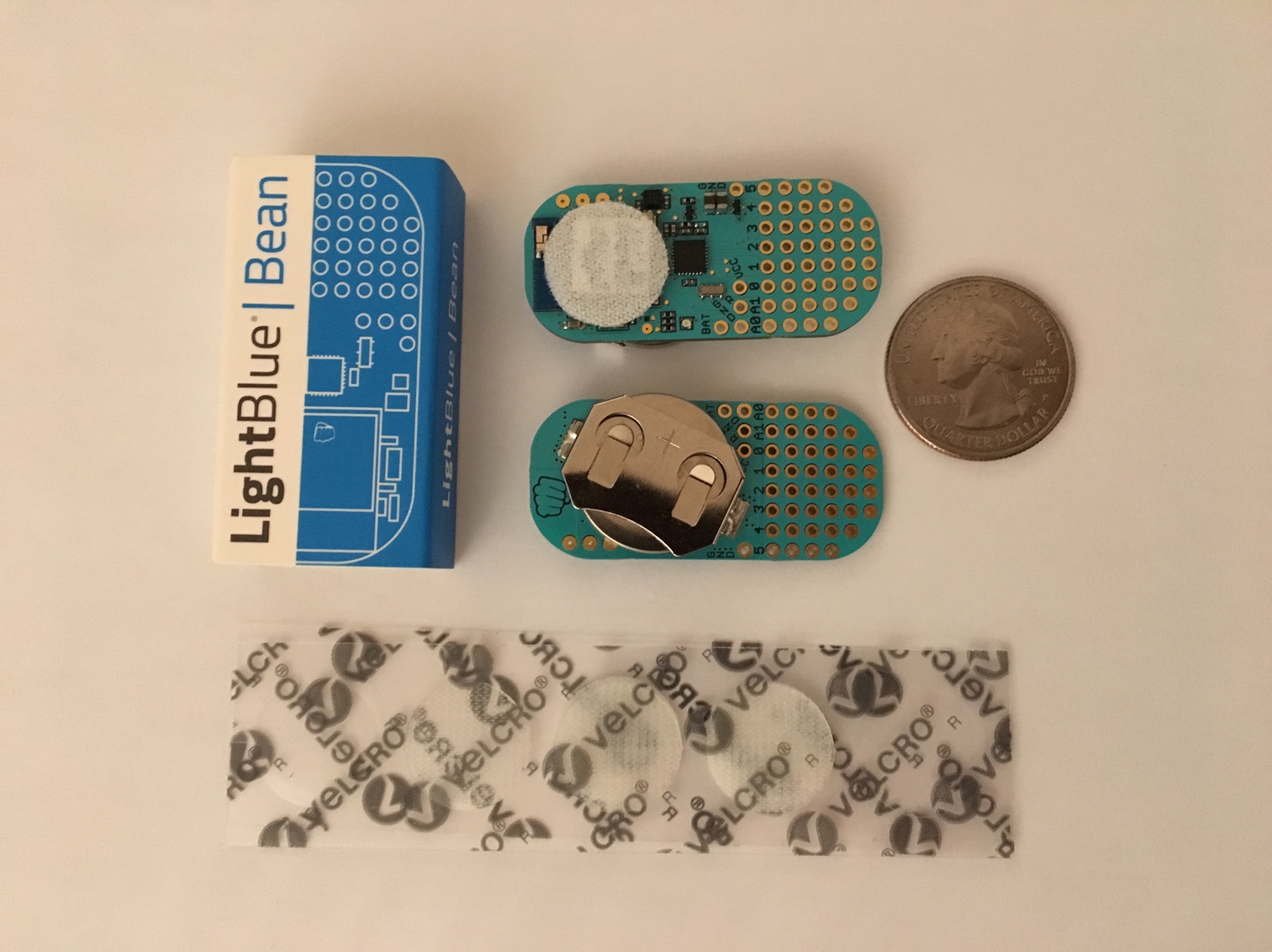
Figure 2. LightBlue Bean, front and back, with Velcro dot strip and quarter for scale.
Accelerometers capture data based on movement: they are a measure of direction in one of three dimensions in space (x, y and z), and the force being directed in that dimension. Consider for a moment what that might mean for our very different technologies. Attaching a sensor to the main wheel of the spinning wheel will cause it measure data in two of three dimensions: up and down, and forward and reverse. But because the wheel is “fixed” on a single axis and does not precess, the z dimension (what we’d call “yaw,” in ship’s parlance), will always register around zero (usually slightly positive or negative because of the unevenness of the surface). Conversely, reading data captured from the movement of a loom shuttle through space, following the weaver’s hand, will express data in all three dimensions. This allows for some interesting effects.
For each sensor we created a corpus of six separate text files: one designed to “match” to recorded instances of x, y and z positive and negative numbers. If a single moment captured produced the string 156, -480, 274, for example, mapping onto x, y and z, the “combine” script would access the “positive x,” “negative y,” and “positive z” files, take snippets from them, and combine them to produce a sentence. Having a machine produce data in only two dimensions would ensure that at least one corpus text would remain permanently “hidden” for the algorithm. In short, we select a text, and we know it’s there, but it will never be expressed in the Twitter feed.
Instructions
Our repository for all scripts is available at the following URL: https://github.com/hyperrhiz/fates.
We include a script for capturing accelerometer data (accelerometer.ino), a script for printing simple numerical data (data.py), a script for taking that data and converting it to sentences using a Markov algorithm (combine.py), and a script that processes all of the above data and posts the resulting poems to Twitter (tweets.py). Load the accelerometer script onto your Arduino board, open up a Terminal, and run data.py or tweets.py (e.g. type “python data.py”) to generate data and post a poem to your own Twitter feed.
Note: The instructions included with the scripts assume that you are familiar with the Arduino IDE, and capable of doing a little troubleshooting where necessary. Because the LightBlue Beans are increasingly difficult to source, we recommend also looking at other versions of the same setup: for example, the same technology could easily be assembled using an Adafruit Flora combined with a Flora BLE module and a Flora Accelerometer module, and powered onboard with a lithium battery. This method of capture may be a little easier, in fact, since the Beans proved to have some tricky problems with serial communication.
Results
For the panel performance, Clotho pre-spun some yarn for Lachesis to weave, using a green-dyed fiber taken from Blue-Faced Leicester sheep. Data was captured while she spun, and that data used to 3D print a corresponding green object. Lachesis wove using the green yarn, producing a small piece of fabric.
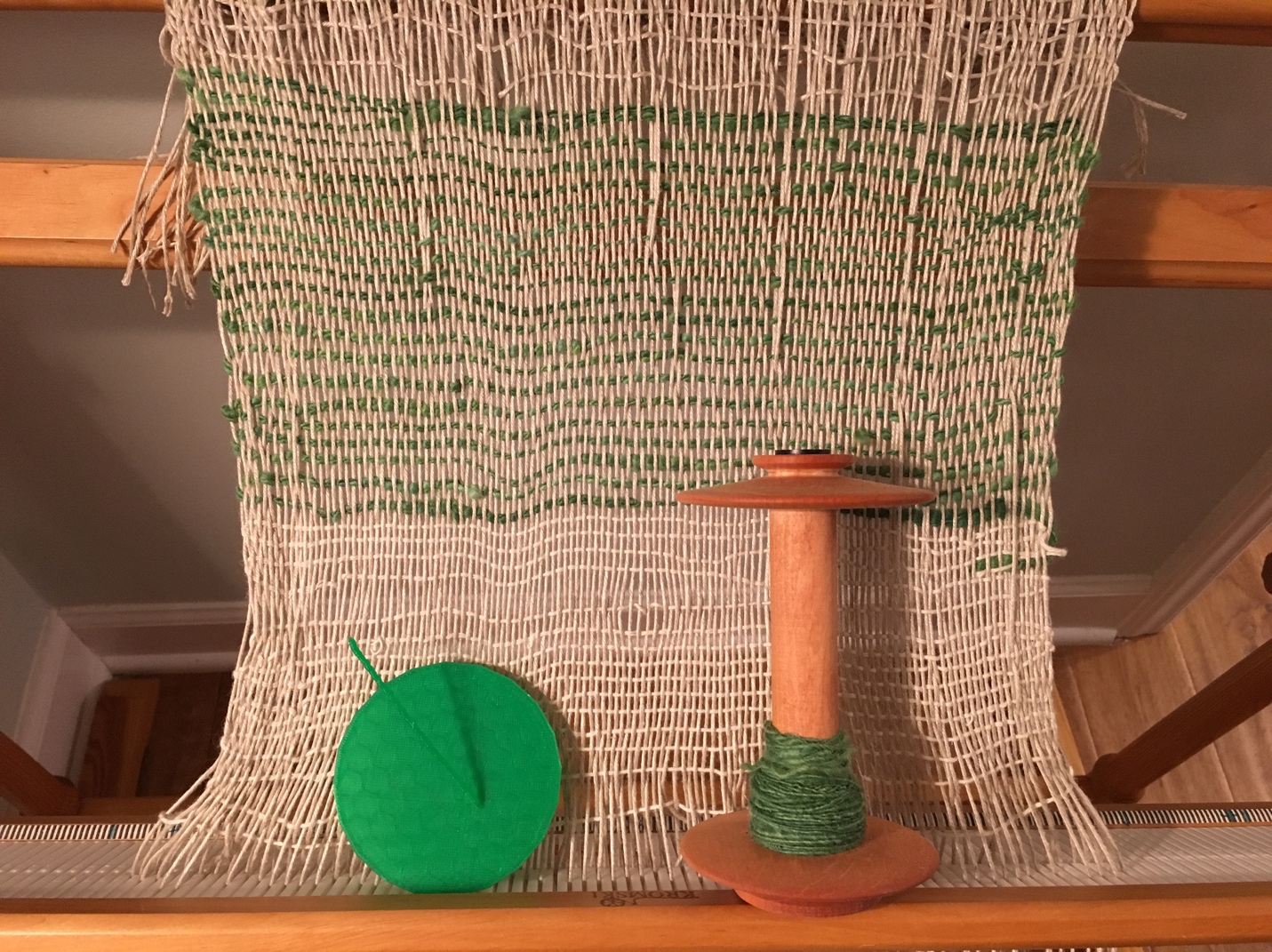
Figure 3. Spun fiber on bobbin, woven textile, 3D printed object. Data determining the object’s shape was captured while spinning the green fiber.
Twitter Feeds
All three technologies were demonstrated in order of presenter, with data captured live and posted to Twitter. The archived feeds for each Fate, therefore, are sentences generated on April 21st 2017, using the movements of our bodies, wheels, shuttles, and the 3D printer head.
Clotho: @fatesofthings, https://twitter.com/fatesofthings
Lachesis: @themeasurer, https://twitter.com/themeasurer
Atropos: @atropos_fated, https://twitter.com/atropos_fated
III: Panel Presentations: R-CADE 2017
The four scripts below are lightly edited from our original oral talks at the R-CADE symposium. Each presenter for the panel delivered an address that used our respective Fate, as well as the texts that we chose to create our textual corpus for our Twitter feeds, to inspire reflections on materiality, embodiment, and textuality as it relates to digital ephemera.
1: Prologue
Today is Parilia, April 21st, festival of the Roman god/goddess Pales, patron of shepherds and flocks. So: let us speak an invocation to the protector of our familial animals, our animal familiars without whom there would be no fleece, no thread, no cloth to cut. From Ovid:
The night has gone: dawn breaks. I’m called upon to sing
Of the Parilia, and not in vain if kindly Pales aids me.
Kindly Pales, if I respect your festival,
Then aid me as I sing of pastoral rites.
Shepherd, purify your sated sheep at twilight:
First sprinkle the ground with water, and sweep it,
And decorate the sheepfold with leaves and branches,
And hide the festive door with a trailing garland….
…
May I drive back as many sheep as dawn revealed,
Nor sigh returning with fleeces snatched from the wolves.
Avert dire famine: let leaves and grass be abundant,
And water to wash the body, water to drink.
May I press full udders, may my cheeses bring me money,
May the wicker sieve strain my liquid whey.
And let the ram be lusty, his mate conceive and bear,
And may there be many a lamb in my fold.
And let the wool prove soft, not scratch the girls,
Let it everywhere be kind to gentle hands.
Let my prayer be granted, and every year we’ll make
Huge cakes for Pales, Mistress of the shepherds.
(The Fasti, Book IV.)
2. Embodying Clotho.
Spin: the way the world turns. Our iron core churns. Our planetary mass produces the steady one G that my accelerometer reads at rest. All things vibrate, whether vital or inert matter. Quantum particles—our bosons, gluons, photons—spin like tiny gyroscopes. Constant speed, variable direction. Feel the whirl of the whorl of the world in your bones. Today I perform Clotho, who spins the thread of life. Clotho, resolutely analog, the only digits my fingers, the only mathematics in the steady beat of my foot. Perhaps digital thinking is a blip. And yet spin is intrinsic to the language of quantum computing. What goes around, comes around.
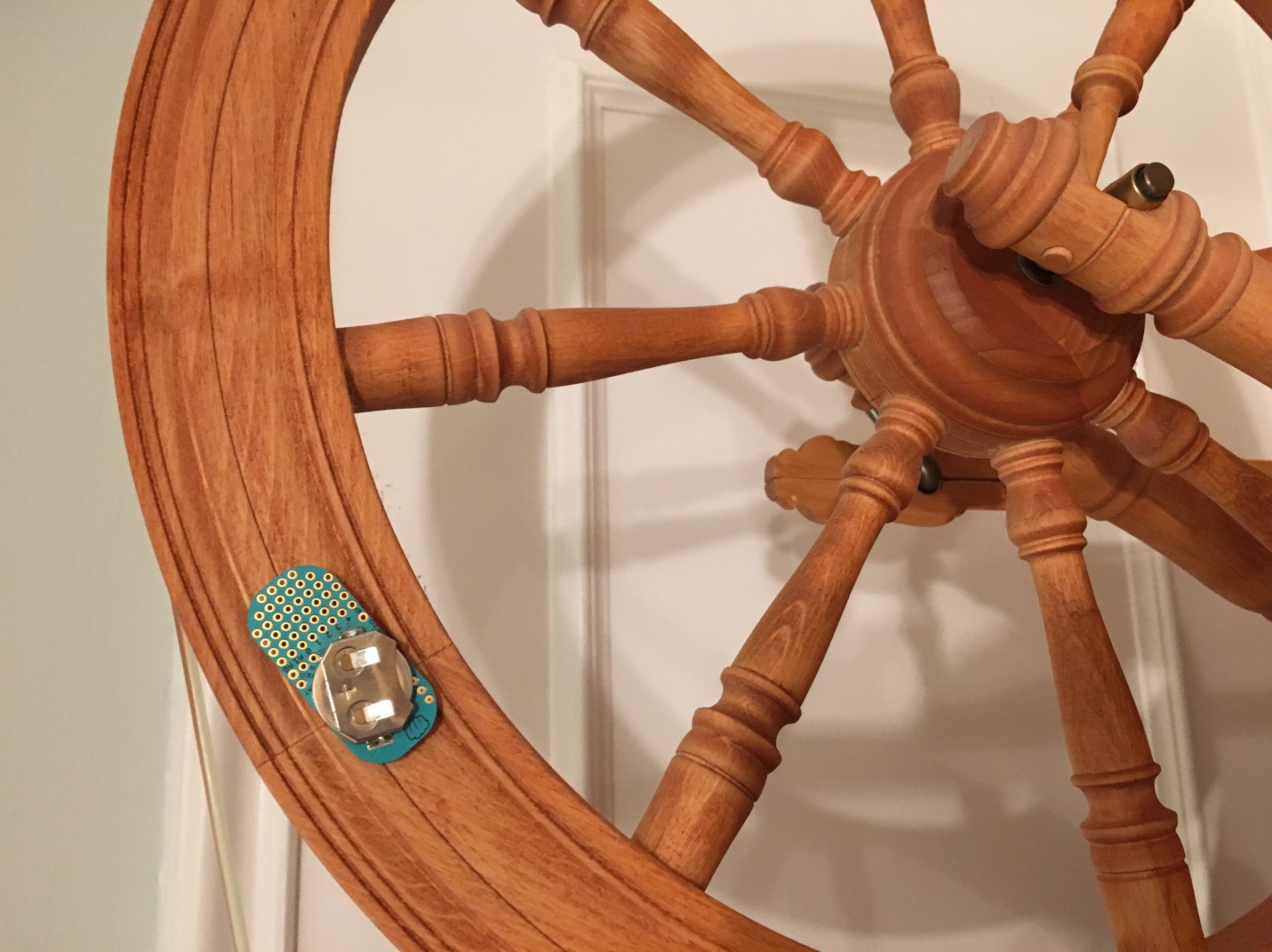
Figure 4. Clotho. Accelerometer attached to main wheel.
Spinning, like any technological assemblage, has its own vocabulary. Short-staple wool, long-staple worsted. Spindle and distaff. The gendering of spinning, like most textile production, leaves intriguing remnants in this dictionary: the bobbin-and-flyer section is traditionally called the “Mother-of-all,” supported by two rods called the “maidens.” In preindustrial European textile-producing households, preparatory fiber work such as carding and spinning was considered “women’s work,” with the more technical activities of finishing and weaving passed on to men. The spinning jenny, invented in Lancashire in 1764, moved domestic textile-production into the factory, with a concomitant shift in the fiber prep labor force from female to male (Odih, 36). In the factories of Lancashire, men operated large-scale spinning machines called “mules,” lubricated by mineral oils. As the spinners worked, they pushed their groins against the carcinogenic oils, leading to a condition called “mule spinners’ cancer,” an epithelioma of the scrotum. Today, gendered spin has shifted further inside to the most intimate parts of the body: a sex-selection technique known as the Ericsson method, but colloquially known as “sperm-spinning,” uses a centrifuge to separate male-coded from female-coded sperm. Spin, in short, is embedded in the world, elementally, socially, materially, and technically.
Clotho’s thread is made of animal, vegetable, or artificial fibers. These fibers take angular momentum—from a wheel, or spindle—and convert it into twist. Stronger together than apart. Take two threads and spin them in reverse, and they ply together, in a twisty embrace. Variable speed, variable direction. Today I’m working with fiber from Blue Faced Leicesters of unknown provenance, known for having a long “staple length” (or fiber length), making hand spinning easier. These sheep are unnamed, but I have other fiber here from two North Carolina alpacas, Juliet and Eli, and from Hazelnut, a tricolor angora rabbit also living in North Carolina. These are my familial animals, my animal familiars. Without Pales, no Clotho. We take alpacas, and turn them into string. The alpaca remains.
In working with accelerometer and spinning wheel, I see movement in two axes, x and y (z, the measure of “yaw,” may have a slight wobble, but it’s mostly stable). Mapping the numbers, I see them move in flux, as in this diagram: x increasing here and here, causing a positive reading, decreasing here and here, causing a negative. Y similarly shifts values from quarter to quarter. Gravity, ever-present, pulls down on the accelerometer whether moving or at rest.
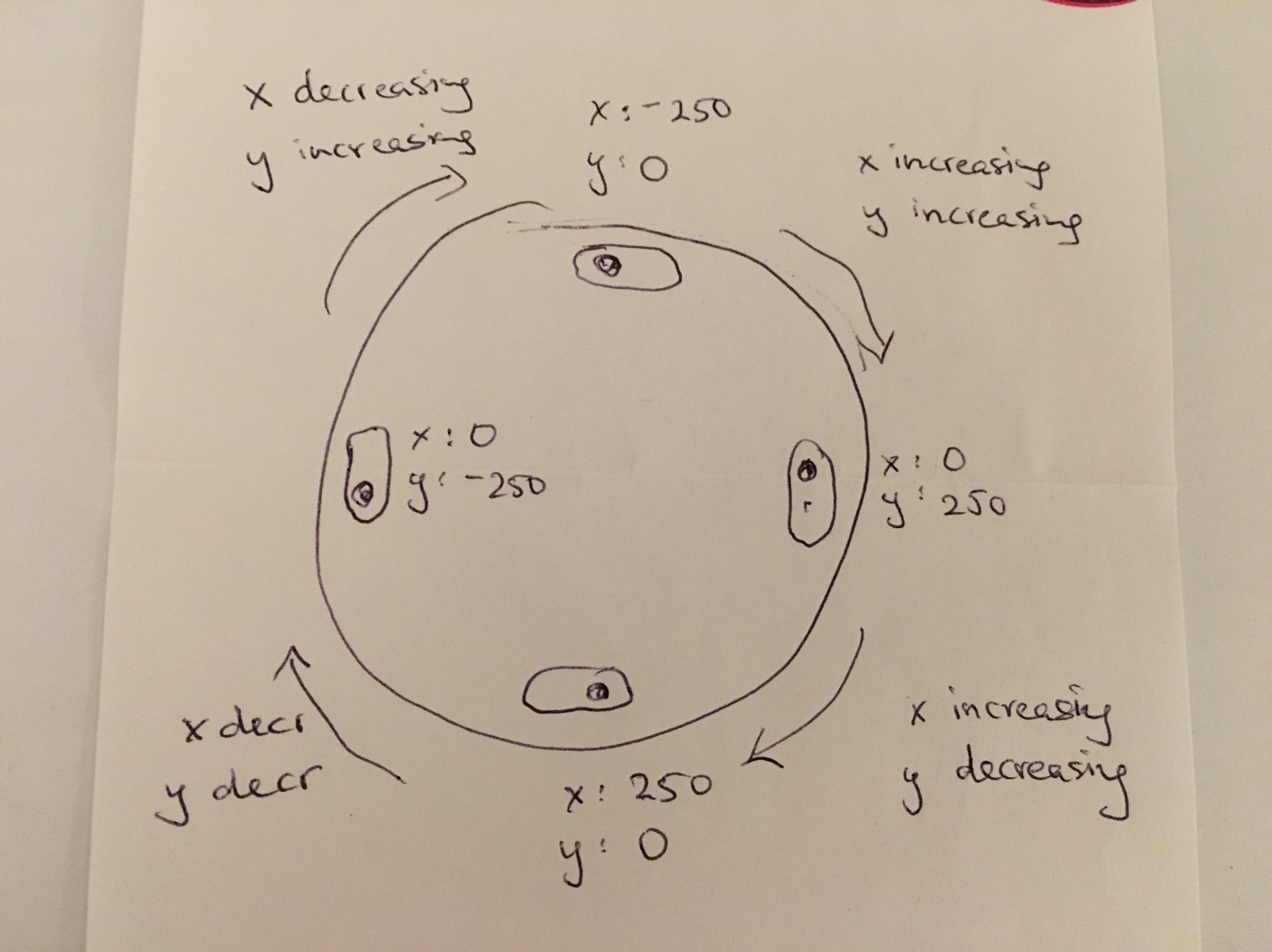
Figure 5. Sketch of x,y axes showing increase and decrease of data values as the wheel turns.
Mapping these shifts I see, to my surprise, my old frenemy from graduate school: the Greimas Square, or semiotic square, what Donna Haraway once characterized as “the clackety structuralist meaning-making machine” that she used for formulating her “four-square cyborg” in her essay on “The Promises of Monsters” (303). In Haraway’s footsteps, thinking of Pales and Clotho, animal and human, I re-map. First: Pales, who watches over the animals, the non-human creators of my fiber. Next: Pales and Clotho, collaborators, human and non-human, in the act of spinning. Third, the animal coauthor fades away, making way for human Lachesis. She measures, leaning in to the digital technology of loom and shuttle, up and down, one and zero. Finally, Atropos, neither animal nor human, maker of the machine-generated objects that appear from captured data.
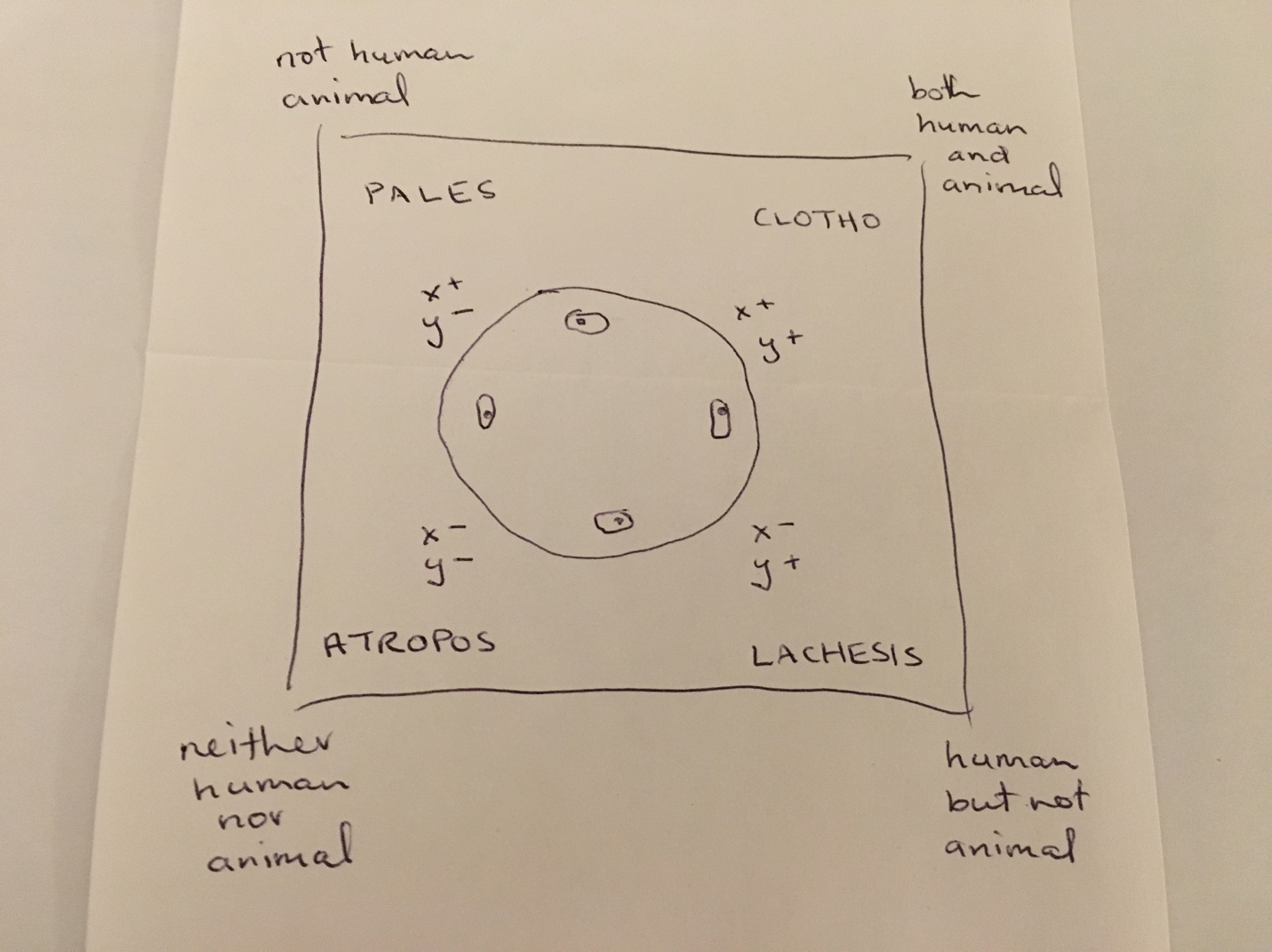
Figure 6. The Fates of Things reimagined as a Greimas square.
The circle is squared. We make string out of alpacas, take its measure, and turn it into shapes that look like sundials. We write mechanical poems from the movements of our hands. We post them to Twitter, clickety-clackety.
For reference, the text corpus Clotho uses consists of the following works:
- The Language of Fashion, by Roland Barthes;
- Tender Buttons, by Gertrude Stein;
- Ovid’s The Fasti, Book 4: the Parilia;
- “Fusus,” from A Dictionary of Greek and Roman Antiquities (1890) edited by William Smith et al.;
- The Scholfield Wool-Carding Machines, 1957, by Grace L. Rogers, from the US National Museum Bulletin;
- “Human/Machine Reconsidered,” by Lucy Suchman; and
- This talk. Because writing is recombination. Or as our animal collaborators might remind us, it’s turtles, all the way down.
3: Embodying Lachesis
I embody Lachesis, the one who measures. When she weaves, Lachesis takes what has been made, a spun thread, and manipulates it before it inevitably will be cut, dismantled. She assigns each thread a length, but she also assigns it a time and a place among others, a relation to herself and to other threads, and a relation to technology. She puts each thread in contact with the loom that coordinates the process that will embed and adjoin threads. Threads never live in isolation once they touch the hands of a weaver. But the journey of a thread is often as hidden as the role and process of the one who engineers its intermeshing. Determining the beginnings and endings of a single thread and fashioning it carefully and tediously into something less like bits and pieces and more like a tapestry is lost to many of us who cannot see the trees for the forest. The radical interconnectivity enabled by the weaver takes on a materiality and density that overwrites the ephemerality of its process.

Figure 7. Lachesis. Boat shuttle, rigid heddle loom, and textile.
Weavers approach digital ephemera, then, from a space in the middle, working not as the originator or author like Clotho nor with responsibility for bringing about an ending like Atropos. Weavers are unruly and often overwritten middle children who stand in the center with processes that transform materials in continual, slow, ongoing patterns. To see it, we have to listen. To quote from Joy Harjo, we have to:
[. . . ] know that there is more
That you can’t see, can’t hear;
Can’t know except in moments
Steadily growing, and in languages
That aren’t always sound but other
Circles of motion. (65)
This middle ground creates forms of relationality characteristic of digital projects and encounters.
Digital making connects and reconnects bodies, tools, and surroundings in ways that create new ways of moving and being. Our bodies often get lost in our descriptions of the digital – their movements and tendencies become a kind of ephemera despite their concrete matter and mass. Lachesis is often represented visually as a body but not described in great detail: the tasks of making become the focus and the body’s movements for carrying out those tasks are easier to overlook. When weaving, the position, size, and shape of the body matters, the orientations and knowledge held in the body matter in relation to the technology. Change the loom and one must change the body that accompanies it. Do I hold my hand here? My foot there?
If the loom in the act of weaving constructs bodily movements and knowledges, what of other technologies? Queer Chicana poet and theorist Gloria Anzaldúa discusses a kind of knowledge enforced on bodies as a habitual and unconscious set of movements and thoughts that should be decolonized, as well as an “intuitive sense, like the intellect of heart and gut” that “reveals a discourse of signs, images, feelings, words that, once decoded, carry the power to startle you out of tunnel vision and habitual patterns of thought” (540). In this middle space—of process, techne, bodily knowledge, intuitive sense, and episteme—digital making intersects in interpretations, thoughts, and movements. These actions are easily lost when technology is positioned primarily as a means to efficiency and progress. Looms are frequently positioned as a forerunner of computing because the shuttles and heddles produce patterns that depend on binary logics. The loom enacts a longstanding vision that we’ve come to rely upon and internalize, and connects digital making to our hopes for augmenting human power.
In “On the Economy of Machinery and Manufactures,” Charles Babbage describes machines as characterized in terms of power, economy of time, and the transformation of raw goods into usable and useful products. In his words, machines can be defined by: “[t]he addition which they make to human power. The economy they produce of human time. The conversion of substances apparently common and worthless into valuable products” (6). By increasing control over environment, the legacy of the digital extends this focus on economy and power through a focus on how ideas can be interconnected through mechanized records with material traces. Vannevar Bush connected this prophesy to computing when describing how the memex would use “repetitive processes of thought” to extend the great “arithmetical machine” (104-5). What does the loom accomplish in terms of human work? How does the loom connect us to or disconnect us from stories we tell ourselves about the relationship between technologies and what it means to be human?
The relationality of making in the middle space also affords us the ability to look at the products of digital making through different lenses. From the middle, it is possible to see how the interconnection of components, made into material, has a tendency to overwrite our ability to remember the processes that led to its production. These processes are a kind of ephemera that digital making affords, but that are always difficult to capture and share. When I weave, I start not only with the thread but also the idea. I draft, I plan, and I make calculations that enable me to begin to create something that takes up space and has materiality. This kind of ephemera is at the heart of the weaving process, the back and forth of the shuttle of weft through warp just a fraction of what it means to weave. The thread is always more easy to visualize than the learning, preparing, or cultivating that makes the material possible. Is it not always the case with digital making? We might turn to think about the vast forms of invisible processes that always support machinery and how humans relate to, create, and use it. We might think of Ada Lovelace, largely credited with working the math behind Babbage’s machine. Lovelace’s correspondence during the years she learned the mathematical processes that informed this collaboration are striking — her struggles with proofs, her constant questioning. These ephemera offer traces of those aspects of the making in the middle space that are lost in our tendency to focus on end points. They represent the easily lost process but also the labor of preparing for process.
Digital making processes involve the conscious and unconscious grafting together of multiple people, places, bodies, thoughts, and information. There are always middle ground kinds of work that both write themselves onto bodies and understandings and that are easily lost to our conscious thought. Weaving has afforded me a perspective on seeing how these threads get connected, as well as an opportunity to reflect on the most ephemeral aspects of such a densely material process. I hope you’ll let us show you more and will try some of these processes out for yourself.
4. Embodying Atropos
I embody Atropos. I cut the thread of life and I fix it in three-dimensional space. I ask you to close your eyes. Pay attention to the room, the sound, the air, what fills it up.
When you look at
a photograph of a person,
and you know in your knowing place
that the person is dead
and she is going to die.
You are compelled to spit out
your dead body.
A mirror. The tool by which Plotnik,
et al proved that pachyderma
were aware of an internal self.
Your moon face. You are dead
in the glass and you touch the spot
where it will occur.
Your face in the glass, the process
of preservation doesn’t always take.
Your skin hanging down
to reveal a body
all tusk.
If you listened carefully, the printer sang to you, coupling its chorus with mine. It made a human sound that called you to watch it, to pay attention to it. It also, perhaps unbeknownst to you, was filling the air with particles from the PLA filament it is melting down into layers and placing on top of one another.
Atropos cuts. Through the death she brings with her scissors, she erases the processes of coming into and out of being, even the process of cutting itself. The digital, also, seemingly erases its presence, dissolving into invisibility after stabilizing a form. The 3D printer—let’s just go ahead and call her Atropos, the Fate of Death—cuts a shape, and that is what you know. You can’t remember the 57th layer she printed; you aren’t supposed to recall the life of that little smiling cat as its body unfolded.
But you do remember; you do recall. I asked you to pay attention, and you did. You know now that there is something there, just at the corner of your eye and ear. You followed the trace of what was left behind in the cutting—the ambient, environmental, bodily traces of the object’s death. You heard the printer’s song, you feel its byproducts in your lungs now. Though you may not be aware, there is little current research that is investigating the effects of PLA filament on the human body. There are ventilation systems in 3D printing labs for just this purpose: dust that flies out of the printer as I speak will be inside you forever—and in this case, forever means far beyond the decomposition of your body.
My goal here is to complicate the notion of digital ephemera by arguing that our technologies are embodied and made visible by their traces. We look at the spinning wheel or the loom and they don’t need me to call your attention to them. They have more weight, they have bodies that we don’t have access to anymore, but the digital also has a body, albeit perhaps a different kind, one that is more permanent in its ability to construct itself as immanence. My argument is that the digital is not ephemeral, that the act of cutting, of printing, of death, creates waste, creates trash, creates traces that have a forever kind of presence.
I want to begin by talking about my process of printing, because it speaks to this idea that the digital and the material are a constantly layered process. Helen sent me data that she had gathered from the spinning wheel. There were three coordinates present, but I had to write a program to parse it into columns and multiply or divide all the numbers in the column by three. These numbers were too large for me to input into my modeling software, and as three is a holy number, this was a good way for me to have some variety in the final form. Once the data was parsed and ready, I loaded everything into a model and was dismayed to find that it didn’t create any kind of three-dimensional object, but a line.
I was so upset by this line, this thing that didn’t represent the complex worlds I knew were coming out of the spinning wheel. After countless meetings with the university libraries to figure out if there was another way I could parse and interpret the numbers from Helen’s wheel, one of the librarians pulled out a protractor to measure the angle of the line. The only way we could print the data was as a line, and the only way we could print a line in three-dimensional space was by measuring its angle with the instrument of a 3rd grader.
For this brand new machine that printed 3D things to rely on an ancient technology was a better confluence than I could imagine. For the line to be the final form of this data was exactly the shape it should have been—for us as scholars considering what gets made and how we define it as digital, for Atropos and her thread, which of course had to have been a line.
The best way to print a line, surprisingly, is not to simply draw the line. The printer is made to create objects in three-dimensional space, so the line needed to exist in three-dimensional space. The best way to accomplish this was by affixing it to a base and having the printer lay down tiny layers, one after the other, a little bit off-center of the previous layer. The result was the sundial objects you see in Figure 8. The result was a symbol of time passing, of time ending, a symbol shaped like the wheel, a symbol woven by lines like the loom.
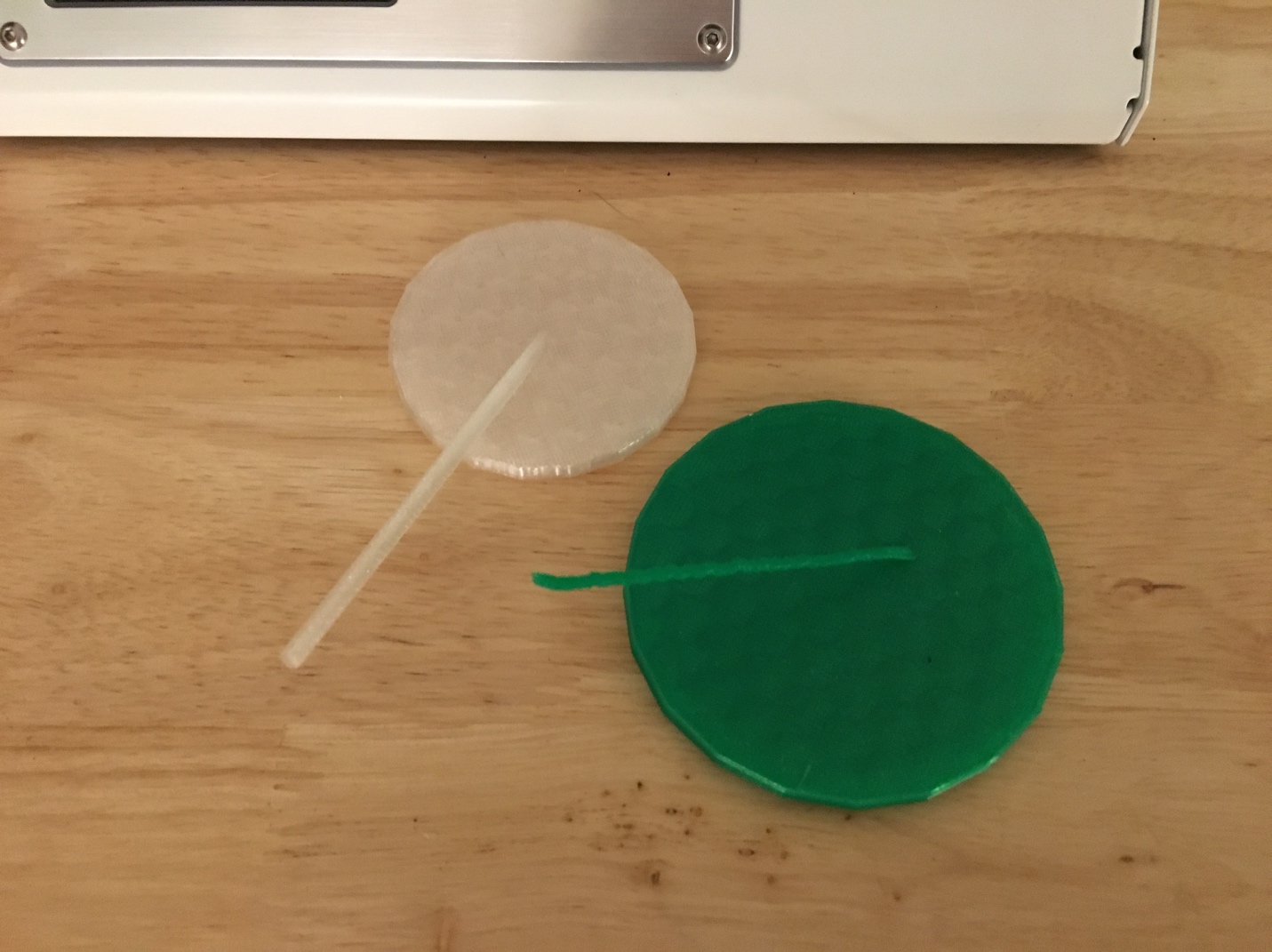
Figure 8. Atropos. 3D printed “sundials” generated from spin accelerometer data.
While these were the steps I took to embody Atropos, there were ambiences that showed up throughout the process that are worth mentioning. If you’ve ever step foot inside a Makerspace, there is usually some kind of ventilation system, as there is little if any research that shows the effects of PLA particles on the human body. A 2011 study directed by Jennifer Saunders and published by the National Academy of Medicine examined the effects of trash-burning in the Iraqi desert, the only recourse soldiers have to getting rid of their waste. In our Circuit Lab, the graduate student space for making that our program provides us, there is no ventilation system. As I printed these Atropos-objects, it became clear to me that no one could say for sure if the particles dusting through the air would end up lodged in my lungs, living on even past my death, the price of graduate study.
Unlike the machine in the Circuit Lab that I had printed my sundials with, Helen’s printer, Atropos, who is here with us now, made for a much more welcoming host. At Helen’s home, we were surrounded by traditional technologies, cats, food, living things. All of us remarked upon the sounds Atropos made. It was even unlike some of the other printers we’ve seen here today. It had its own voice, its own song, and it sang to us as we worked.
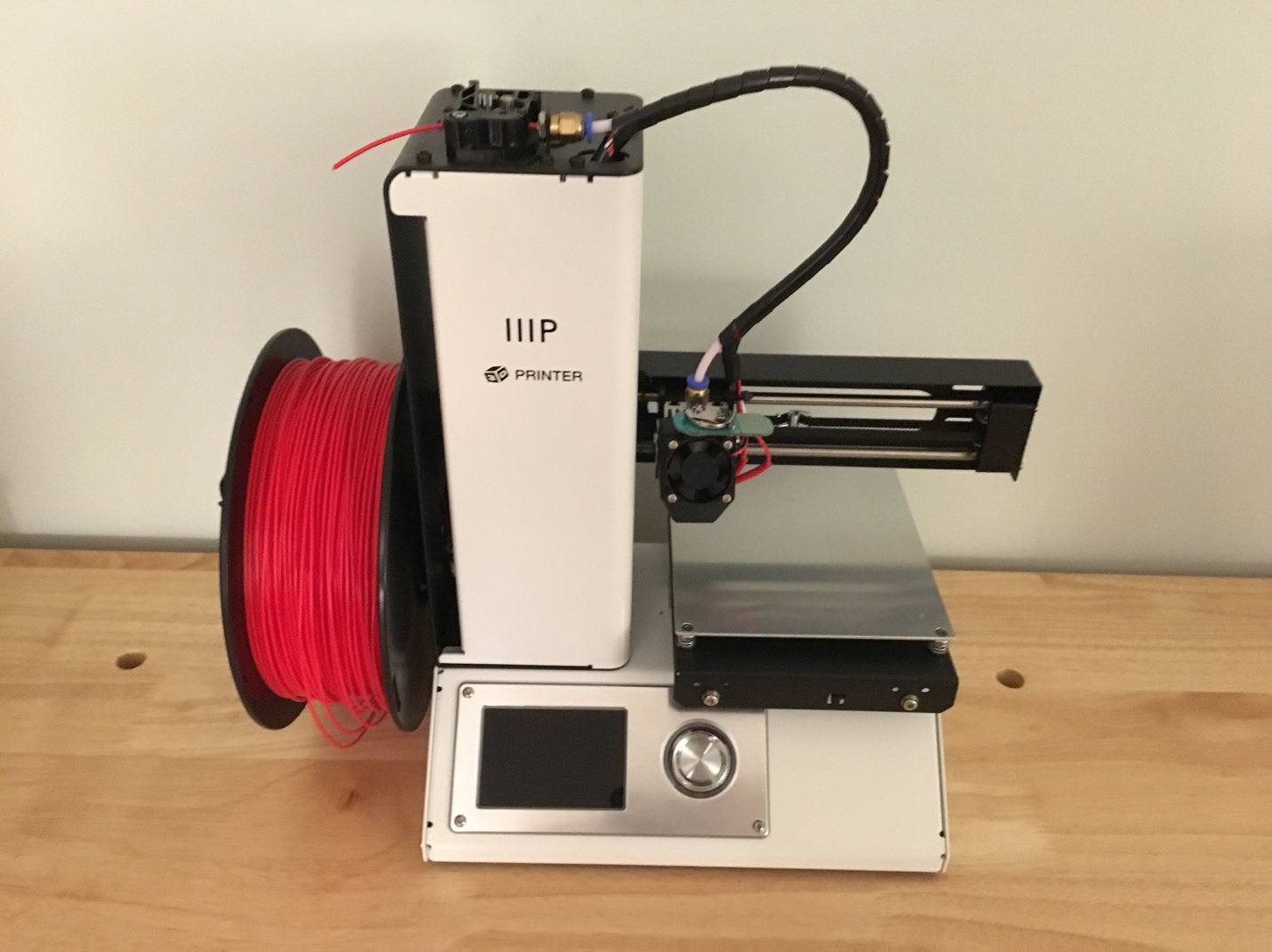
Figure 9. Atropos. Machine collaborator: Monoprice IIIP 3D printer.
The final step of the process was for the three of us to choose six texts for Helen’s Twitter bot. As I was choosing texts, I was really thinking about this idea of death and its byproducts. I ended up choosing Derrida’s hauntology, two pieces by Stern about the waste of technology, Kittler’s “There is No Software,” a set of my own poems, some texts related to Atropos, and Joyelle McSweeney’s essay on the necropastoral, which is a recent movement in poetry that aims to highlight the Anthropocene’s role in art and writing—how Death as a character or as a landscape gets woven through the site of poetic making.
In thinking about what these texts mean for this project, I came to two ideas that I’d like to explore here: the role of Death in this story, and the waste that it leaves behind. Sterne writes that technology’s work is to split a subject from its body, to erase the body, and yet tech has a physical infrastructure. It has weight and presence in its constant turnover, in its dying. The cloud sits somewhere in a data center gathering dust, the erased files on our hard drive leave minute scratches that can then be drug up for forensic purposes.
When we think of Moore’s law, an understanding that technology necessitates its own death, we also can consider how technology necessitates its own waste. The image for McSweeney’s essay on the necropastoral is a sea bird of some kind dead in the sand, its body decomposed to reveal none else but the massive amount of trash that it has eaten over its lifetime. The necropastoral is about waste, about the ways that technology lingers in us, even inside us. I think of this as we sit here, breathing in the plastic fumes from the 3D printer, not actually knowing its effect on our bodies, but not really rushing to find out either. How are our bodies being visited by the ghost of this technology? How are we, ourselves, becoming fixed by its supposed ephemerality?
Derrida’s hauntology helps me theorize the ways that the digital is not ephemeral, but lasting and persisting. Digital technology—everything from this printer to the Internet of Things to sensor implants—has a physical denseness. The printer is here, it has weight, and it has presence. But by constructing the printer as a commodity, as “digital,” it becomes ephemeral, magical, it has weight but it is fleeting too. Derrida says that we can touch it but we can’t, we can sense it, but there’s nothing there to sense, like a ghost limb. While I see this notion of the commodity-spectre at play, I also see the digital’s hauntology as something that is, in fact, material. We know the particles are inside us, but we can’t touch them or see them. And perhaps even when we talk about something like data, like the data coming in from the sensors here, something that has no presence, we sense it. We have a notion of something material, weighty, coming into being.
Atropos, the Fate of death, cuts the thread of life. While she’s here with us, cutting the PLA filament, fixing it in space as her sundial, as the product after process, we recognize her work as something ends/erases life and yet ushers souls on in a kind of tracing. There are a few threads hanging from her scissors, another afterlife beginning in the kingdom of the dead. I call for us to consider our technology, all of the technologies we’ve seen today, in this light, as trash-spectres, as bodiless bodies that live inside us as we decompose, as things that have permanence in death.
IV. Conclusion
We share these materials with the hope that they will be reused, remixed, and reinvigorated in new events that enable you to uncover and forge new connections between old and new, between digital and analog, between birth and death, between invention and destruction, between archived and performed, and between remembered and forgotten. When thinking through the implications of textiles at the complex intersections of technology embodiment and use, we found enough material to keep us busy for much longer than the R-CADE panel alone. We invite you to inhabit these embodiments and hope that you will share your experiences.
Anzaldúa, Gloria E. “now let us shift . . . the path of conocimiento . . . inner work, public acts.” This Bridge We Call Home, edited by Gloria E. Anzaldúa and Analouise Keating, Routledge, 2002, pp. 540-578.
Babbage, Charles. On the Economy of Machinery and Manufactures. Project Gutenberg, http://www.gutenberg.org/ebooks/4238.
Barthes, Roland. The Language of Fashion, translated by Andy Stafford, Bloomsbury, 2013.
Bradley, Catherine and Kat Lind. “The Virtual Textile Project,” McGill University, 2018. https://github.com/mcgilldh/virtualtextileproject.
Bush, Vannevar. "As We May Think," The Atlantic. July 1945, pp. 101-108. https://www.theatlantic.com/magazine/archive/1945/07/as-we-may-think/303881/
Derrida, Jacques. Specters of Marx, translated by Peggy Kamuf, Routledge, 1994.
Drucker, Johanna. “Performative Materiality and Theoretical Approaches to Interface.” Digital Humanities Quarterly, vol. 7, no. 1, 2013. http://digitalhumanities.org:8081/dhq/vol/7/1/000143/000143.html.
“Fusus.” Dictionary of Greek and Roman Antiquities, edited by William Smith LLD et al., John Murray 1890. http://www.perseus.tufts.edu/hopper/textdoc=Perseus%3Atext%3A1999.04.0063%3Aentry%3Dfusus-cn
Haas, Angela M. “Wampum as Hypertext: An American Indian Intellectual Tradition of Multimedia Theory and Practice.” Studies in American Indian Literatures, vol. 19, no. 4, Winter 2007, pp. 77-100.
Haraway, Donna. “The Promises of Monsters: A Regenerative Politics for Inappropriate/d Others.” Cultural Studies, edited by Lawrence Grossberg, et al., Routledge, 1992, pp. 295-337.
Harjo, Joy. “Eagle Poem.” Mad Love and War. Wesleyan UP, 1990, p. 65.
Kittler, Friedrich. “There Is No Software.” The Truth of the Technological World. Essays on the Genealogy of Presence. Stanford UP, 2014, pp. 219-229.
McSweeney, Joyelle. The Necropastoral: Poetry, Media, Occults. U of Michigan P, 2015.
Odih, Pam. Gender and Work in Capitalist Economies. McGraw-Hill, 2007.
Ovid. “Book IV: April 21: The Parilia.” The Fasti, translated by A. S. Kline, 2004. http://www.poetryintranslation.com/PITBR/Latin/OvidFastiBkFour.htm#anchor_Toc69367860.
Ríos, Gabriela Raquel. Ixtili in yollotl / A (wise) face a (wise) heart: Reclaiming Embodied Rhetorical Traditions of Anuahuac and Tawaninsuyu. Dissertation Projects, Texas A & M University, 2012.
Rogers, Grace L. “The Scholfield Wool-Carding Machines.” US National Museum Bulletin, 1957. https://www.gutenberg.org/files/27137/27137-h/27137-h.htm.
Saunders, Jennifer. Long-Term Health Consequences of Exposure to Burn Pits in Iraq and Afghanistan. Washington, DC: The National Academies Press, 2011. https://doi.org/10.17226/13209.
Stein, Gertrude. Tender Buttons. City Lights Press, 2014.
Sterne, Jonathan. “Out with the Trash: On the Future of New Media.” Residual Media, edited by Charles R. Acland, U of Minnesota P, 2007, pp.16-31.
Suchman, Lucy. “Human/Machine Reconsidered.” Cognitive Studies, vol. 5, no. 1, 1998, pp.5-13.
Trettien, Whitney. “Isabella Whitney’s Slips: Textile Labor, Gendered Authorship, and Modern Miscellany.” Journal of Medieval and Early Modern Studies, vol. 45, no. 3, 2015, pp. 505-521.
Wernimont, Jacqueline. “Introduction to Feminisms and DH Special Issue.” Digital Humanities Quarterly, vol. 9, no. 2, 2015. http://digitalhumanities.org:8081/dhq/vol/9/02/000217/000217.html.